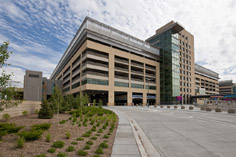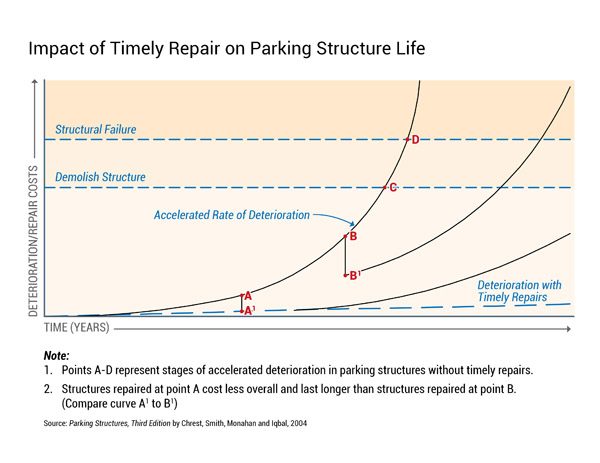Latest News
Parking Plan for MSP Airport

By Jerry Pertzsch, Allen Dye, P.E., and Rick Decker
When you’ve got a flight to catch at the Minneapolis-St. Paul International Airport (MSP), parking may not be the first thing on your mind. But keeping parking spaces available and usable is a primary concern for the MSP Airport.
With nearly 24,000 spaces in six parking ramps at two terminals, the Metropolitan Airports Commission (MAC) faced the challenge of planning and executing an annual parking ramp repair and maintenance plan that would minimize impacts to parking ramp customers.
Prior to 2006, parking ramp repairs were performed on an as-needed basis. Annual maintenance activities, such as cleaning the decks, restriping pavement markings, and relamping the lights, were performed by MAC staff as their schedule allowed. This resulted in unpredictable parking ramp closures for the customers, and parking ramps were not receiving the maintenance necessary to maximize their service life.
In 2006, Kimley-Horn and Associates, Inc. worked with MAC to initiate a parking structure rehabilitation program to proactively maintain their $600 million parking ramp investment.
The goals of the program were to:
- Develop a comprehensive, multi-year parking ramp repair and maintenance plan.
- Proactively maintain the parking structures to prolong service life.
- Integrate the construction schedule for repairs with the annual maintenance schedule.
- Maintain a high level of customer service during repairs and maintenance.
- Budget for the repairs and maintenance work in their annual capital improvement plan (CIP).
The first step in the program was to conduct a condition assessment of each parking ramp to document the condition and identify repair needs. With this data, short-term and long-term repair needs were identified and prioritized for a six year period along with the estimated costs. This allowed MAC to program funds in the CIP annually and level out repair and maintenance expenditures.
This proactive approach allows MAC to extend the service life by getting ahead of the deterioration curve (shown in Figure 1, below), thereby reducing future maintenance costs. Updates to the condition assessment report are performed every three years, and the priorities are confirmed and adjusted as needed for the next six years. From this update, the annual work within the budget is prioritized, planned, and completed.
 Typical annual repairs include concrete repairs, expansion joint replacements, caulk joint replacements particularly in the precast concrete structures, application of deck sealers and traffic membranes, drain and piping repairs, railing repairs and their painting, precast joint repairs, and stair/elevator core repairs.
Typical annual repairs include concrete repairs, expansion joint replacements, caulk joint replacements particularly in the precast concrete structures, application of deck sealers and traffic membranes, drain and piping repairs, railing repairs and their painting, precast joint repairs, and stair/elevator core repairs.
The biggest challenge facing MAC is scheduling the work to minimize customer inconvenience of being diverted from Terminal 1 to Terminal 2 and lost revenue. The program developed by MAC with the help of Kimley-Horn meticulously outlines a schedule that coordinates the construction activities and maintenance activities for the upcoming year.
This process starts with identifying the construction work scope and with parking operations staff using statistical data to project parking demand for each week of the construction season. Based on these projections, the maximum number of parking levels out of service at each terminal for each week is identified. From this information, multiple possible schedules are developed and discussed with parking operations and maintenance staff, and a schedule is developed for the upcoming year. The schedule specifies dates when each level of each ramp is available to the contractor to perform the work, and MAC maintenance staff to perform their work and becomes part of the contract document.
Development of the coordinated construction and maintenance schedule has reduced the number of closures required as maintenance activities on a level are scheduled to immediately follow the construction work which utilizes one closure for both purposes. This minimizes the inconvenience and maximizes customer service.
Signs inform customers entering the parking structures when a level will be closed and identify the period of closure. This is especially important for customers needing to park for an extended period of time to ensure that their ramp parking area will not be impacted by upcoming construction.
Some work repair and preventative maintenance work has taken place in four floor plates occupied by rental car agencies at Terminal 1. Through close coordination with the impacted rental car companies, this work has been phased to minimize the effect on daily operation of the agencies. Work is scheduled between 10 PM and 6 AM, Monday night through Friday night. This window of time provides adequate time for the contractor to perform the work and materials to cure, prior to returning the area to operation during the day.
The development of a long-term plan for the repair and maintenance of the parking ramps has enabled MAC to extend the service life and quality of the parking structures. The development of the coordinated schedule for maintenance and construction minimizes customer inconvenience, provides a higher level of customer service, and offers an example that can be readily adapted by other large parking garage operators.
By Jerry Pertzsch, P.E. Kimley-Horn and Associates, Inc.; Allen Dye, P.E. and Rick Decker, CAPP Metropolitan Airports Commission
What's New
-

Young Professionals Spotlight
March 25, 2024
-

APWA-MN Education Programs
March 25, 2024
-
Apply for the Young Professionals Stipend: Attend PWX Atlanta
February 23, 2024



